-
Accelerator neutron sources are widely used in neutron physics and neutron applications, owing to the high neutron yield, good controllability, compactness, and nonproliferation capability [1-9]. Typically, in exothermic nuclear reactions, deuterons and tritons are bombarded with deuterium ions, producing fusion neutrons by the 2H(d,n)3He (D-D) and 3H(d,n)4He (D-T) reactions, and deuterium ions bombard beryllium, producing neutrons by the 9Be(d,n)10B (D-Be) reaction for low energy
$ {D}^{+} $ ions at$\sim {10}^{2} $ keV.Compared with deuterium-adsorption targets and tritium-adsorption targets, metallic beryllium exhibits stable chemical properties and excellent hardness. Pure metallic beryllium targets are easy to obtain, and they can be easily processed into various shapes. Beryllium has a high melting point (1280 °C) and good thermal conduction, which allows metallic beryllium targets to withstand high intensity
$ {D}^{+} $ ion beams. Most importantly, the cross section of the 2H(d,n)3He (D-D) reaction is roughly equivalent to the 9Be(d,n)10B (D-Be) reaction for low energy$ {D}^{+} $ ions at$ \sim {10}^{2} $ keV. As a result, accelerator-based 9Be(d,n)10B reaction neutron sources can generate high intensity and continuous-spectrum neutron fields at low energy deuterium ions.The 9Be(d,n)10B reaction is relatively complex. Forlow-energy deuterium ions, 9Be(d,n)10B is an exothermic reaction with
$ Q $ = +4.36 MeV, but there are four well-known excitation states of 10B [10, 11]. With increasing energy of deuterium ions, several many-body reactions (9Be(d,2n)9B ($ Q $ = −4.1 MeV), 9Be(d,np)9Be ($ Q $ = −2.2 MeV), and 9Be(d,2np)8Be ($ Q $ = −3.8 MeV)) markedly enhance the neutron yield and extend the neutron energy spectrum. However, measurements of the neutron energy spectra, angular distribution, and integrated yields for the 9Be(d,xn) reaction have been scarce, and the existing studies mainly focus on the deuterium ion energies from a few MeV to tens of MeV [10-36]. Some notable exceptions are a study by Coombe et al., who measured the neutron energy spectra from the 9Be(d,n)10B reaction for 80 keV deuterium ions at$ 0^\circ $ and$ 45^\circ $ [37], and a study by Zou et al., who measured the angular distribution and neutron yields from the 9Be(d,n)10B reaction for 200 and 500 keV deuterium ions [38].The 9Be(d,n)10B reaction is a typical direct reaction, and the angular distribution of the 9Be(d,n)10B neutron source presents a forward trend. Neutrons from direct reaction mechanisms are still visible at larger neutron emission angles, but the relative intensity and the positions of maxima decrease with the angle. Consequently, it is more beneficial to select forward angles for studying the branching ratio of the 9Be(d,n)10B reaction.
In this work, novel measurements of the neutron energy spectra of the 9Be(d,n)10B reaction with a thick beryllium target were performed for the neutron emission angles of
$ \theta = 0^\circ $ and$ 45^\circ $ , and the respective incident deuteron energies were 250 and 300 keV. This work provides basic information for accelerator-based D-Be neutron sources used in neutron physics and neutron applications. -
The measurements of the neutron energy spectra of the 9Be(d,n)10B reaction with a thick beryllium target for low energy deuterium ions were performed using a fast neutron time-of-flight (TOF) spectrometer and a Cockcroft-Walton accelerator at the China Institute of Atomic Energy (CIAE). The experimental setup is shown in Fig. 1. The Cockcroft-Walton accelerator provided
$ {D}^{+} $ ions at 250 and 300 keV with a frequency of 1.5 MHz and pulse width of 2.5 ns. The target used in this experiment was a pure metallic beryllium sample with a diameter of 22.0 mm and thickness of 1.0 mm in the$ 0^\circ $ direction with respect to the deuteron beam.
Figure 1. (color online) The experimental setup for measuring the neutron energy spectra of the 9Be(d,n)10B reaction.
The fast neutron TOF spectrometer was employed at
$ 0^\circ $ and$ 45^\circ $ for measuring the neutron energy spectra of the 9Be(d,n)10B reaction. The spectrometer consisted of a BC501A liquid scintillator with a diameter of 5.08 cm and thickness of 2.54 cm, and a HAMAMATSU R329-02 photomultiplier tube. The flight length of the emitted neutrons between the metallic beryllium target and the front surface of the detector was 3.0 m. In this experiment, the threshold of the BC501A liquid scintillator detector was 0.191 MeV. A silicon surface barrier detector (SSD) was placed in the$ 135^\circ $ direction with respect to the deuteron beam, to monitor the neutron yield by counting the associated protons from the D(d,p)T reaction owing to the deuterium ions bombarding self-injecting deuterons in the target, because the D(d,n)3He reaction occurred along with the D(d,p)T reaction. The SSD was positioned at 90 cm from the Be sample target.In addition, the deuteron beam self-injected into a beam-limiting diaphragm, and deuterium ions bombarded self-injected deuterons in the beam-limiting diaphragm, to produce neutrons by the D(d,n)3He reaction. These neutrons were also responded to in the BC501A liquid scintillator detector. To determine the position of the D(d,n)3He neutron peaks in the neutron TOF spectra and neutron energy spectra, the neutron flight distances from the beam-limiting diaphragm to the BC501A liquid scintillator detector are shown in Fig. 1.
$ L1 $ is the neutron flight distance at$ 0^\circ $ , which was 3.230 m.$ L2 $ is the flight distance at$ 45^\circ $ , which was 3.134 m.In the experiment, all of the events that were detected by the detector were recorded in a list mode on a single event basis, using a CAMAC data acquisition system. Each event was characterized by three parameters: the pulse height (PH), pulse shape discrimination (PSD), and TOF. The PH and PSD parameters were used for the detection threshold determination and n-
$ \gamma $ discrimination, respectively, in the offline analysis. -
As shown in Fig. 1, the BC501A liquid scintillator detector was used as the primary detector in the experiment, for measuring the neutron spectra. Although the BC501A liquid scintillator detector is sensitive to both neutrons and gamma rays, the output pulse shapes for neutrons and gamma rays in liquid scintillator detectors are different, allowing to distinguish neutron and gamma signals. In this work, a 4-channel pulse shape discriminator was used for distinguishing the detected neutron and gamma signals using the zero-crossing time method for all measured TOF, and gamma signals were rejected. Neutron-only TOF spectra were obtained by filtering the mixture TOF spectra of neutrons and gamma rays, choosing neutron signals in the two-dimensional distributions of the zero-crossing time versus pulse height produced by the BC501A liquid scintillator detector. This filtering was performed offline.
Figure 2 shows the measured TOF spectra of the 9Be(d,n)10B reaction, for deuteron energies of 250 and 300 keV and neutron emission angles of
$ 0^\circ $ and$ 45^\circ $ , respectively. The time-zero ($ Ch_{0} $ ) in the experimentally measured neutron TOF spectra was determined as$ \ Ch_{0} = P+L /(c\times W) $ , where$ P $ is the gamma peak position in the measured neutron TOF spectrum,$ L $ is the neutron flight distance,$ W $ is the channel width of time-to-amplitude converters (TACs), and$ c $ is the flight speed of gamma-rays. In this work,$ P $ was determined by comparing the neutron-only TOF spectra and the mixture TOF spectra of neutrons and gamma rays. The additional parameters were$ L $ = 3.0 m and$ W $ = 0.23 ns, while$ c $ was the speed of light.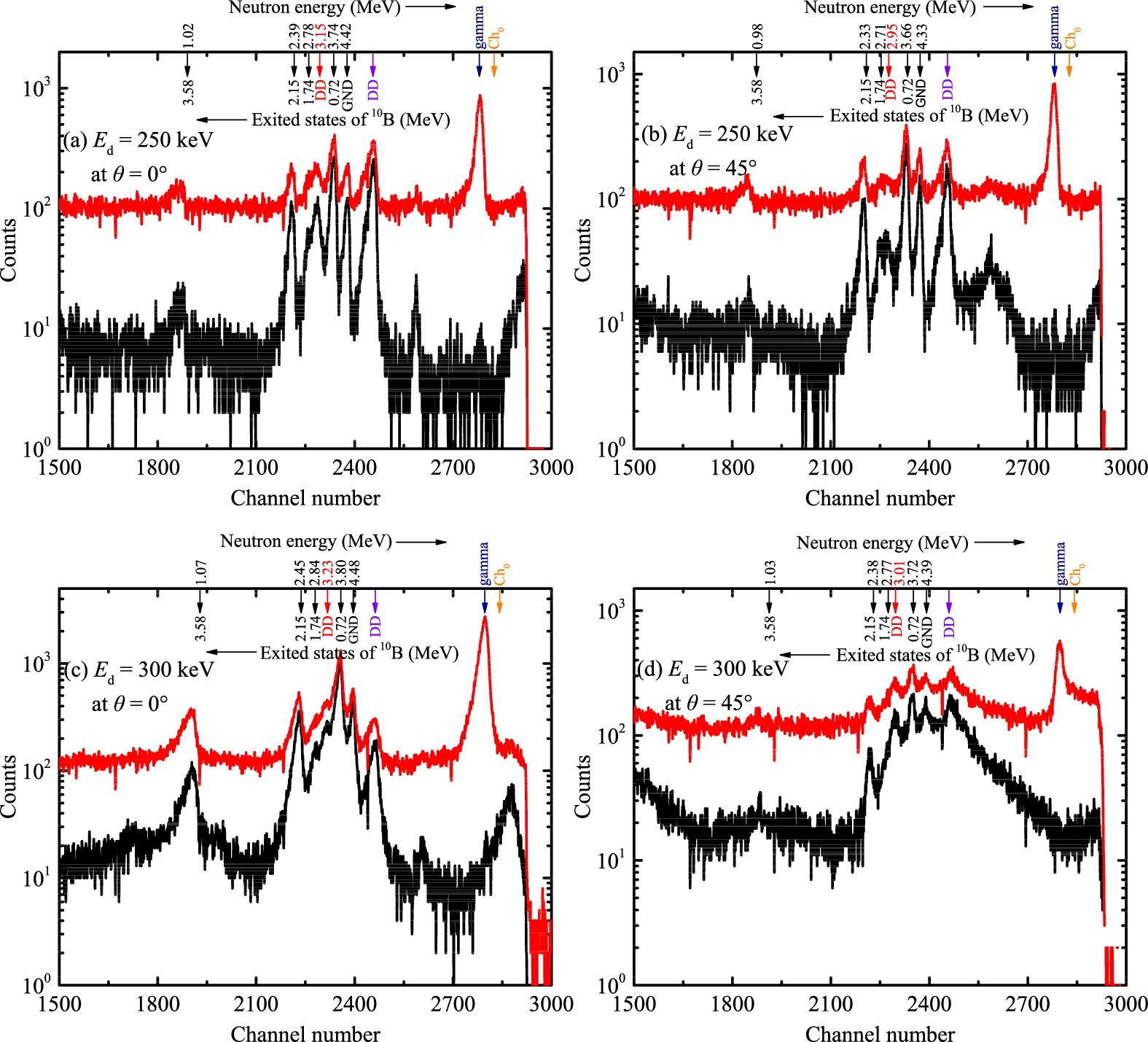
Figure 2. (color online) The measured TOF spectra of the 9Be(d,n)10B reaction, for deuteron energies of 250 and 300 keV and neutron emission angles of 0° and 45°, respectively. The channel width is 0.23 ns. The red solid curves denote the mixed TOF spectra of neutrons and gamma rays. The black solid curves denote the neutron-only TOF spectra. Arrows are the calculated results. The red arrow represents neutrons from the D(d,n)3He reaction, for the metallic beryllium target. The violet arrow represents neutrons from the D(d,n)3He reaction, for the beam-limiting diaphragm. The navy arrow represents gamma-rays. The orange arrow represents the time-zero of the TOF. The black arrows are neutrons from the 9Be(d,n)10B reaction, and, from right to left, mark the ground state (Q = 4.36 MeV), first excited state (Q = 3.64 MeV), second excited state (Q = 2.62 MeV), third excited state (Q = 2.21 MeV), and fourth excited state (Q = 0.78 MeV) of 10B.
As shown in Fig. 2, gamma responses can be well excluded from the measured TOF spectra of the 9Be(d,n)10B reaction. We observed six neutron energy peaks in the 1800-2500 range, corresponding to neutrons from the 9Be(d,n)10B reaction for different excited states of 10B, as well as neutrons from the D(d,n)3He reaction for the beam-limiting diaphragm and the metallic beryllium target. The peak positions in the experimentally measured TOF spectra all agreed well with the calculated results. The relationship between the neutron energy and the neutron TOF was described by
$ T_{n} = \frac{72.306\times L}{\sqrt{E_{n}}}, $

(1) where
$ E_{n} $ is the neutron energy,$ T_{n} $ is the neutron TOF, and$ L $ is the neutron flight distance. -
The measured TOF spectra were converted into the neutron energy spectra based on the neutron flight distance, the channel widths of the TACs, and the gamma peak positions. Typical results are shown in Fig. 3. All of the measured neutron energy spectra were modified by the neutron detection efficiency of the BC501A liquid scintillator detector, calculated using the NEFF code [39].

Figure 3. (color online) The measured neutron energy spectra of the 9Be(d,n)10B reaction, for deuteron energies of 250 and 300 keV and neutron emission angles of 0° and 45°, respectively. Arrows indicate the results of the calculations. The red arrow marks the energy of the neutrons from the D(d,n)3He reaction, for the metallic beryllium target. The violet arrow marks the energy of the neutrons from the D(d,n)3He reaction, for the beam-limiting diaphragm. The black arrows mark the energies of the neutrons from the 9Be(d,n)10B reaction, for 10B in different excited states.
As for the 9Be(d,n)10B reaction, emitted neutrons haddifferent energies, because 10B can be in different excited states [15, 20]. The excited states of 10B are 0, 0.72, 1.74, 2.15, 3.58, and 5.17 MeV, corresponding to the
$ Q $ -energies of 4.36, 3.64, 2.62, 2.21, 0.78, and -0.81 MeV, respectively. The energies of the emitted neutrons for the different excited states of 10B can be calculated using the$ Q $ -equation [40]$ \begin{aligned}[b] E_{n} = &\frac{m_{d}\times m_{n}}{(m_{n}+m_{B})^2}\times E_{d}\\&\times\left[{\rm cos}\theta_{\rm L} \pm \sqrt{{\rm cos}^2\theta_{\rm L}+\frac{m_{n}+m_{B}}{m_{d}\cdot m_{n} }\left(m_{B}-m_{d}+\frac{Q}{E_{d}}\cdot m_{B}\right)}\right]^2, \end{aligned} $

(2) where
$ E_{d} $ is the incident deuteron energy, and$ m_{d} $ ,$ m_{n} $ , and$ m_{B} $ denote the masses of the deuteron, neutron, and boron, respectively.$ Q $ is the$ Q $ -energy of the 9Be(d,n)10B reaction, and$ \theta_{\rm L} $ is the neutron emission angle in the laboratory system.The measured neutron energy spectra of the 9Be(d,n)10B reaction, for deuteron energies of 250 keV and 300 keV and neutron emission angles of
$ 0^\circ $ and$ 45^\circ $ , are shown in Fig. 3. We observe six typical neutron energy peaks, corresponding to the neutrons from the D(d,n)3He reaction for the beam-limiting diaphragm, neutrons from the 9Be(d,n)10B reaction for the ground state of 10B ($ Q $ = 4.36 MeV), neutrons from the 9Be(d,n)10B reaction for the first excited state of 10B ($ Q $ = 3.64 MeV), neutrons from the D(d,n)3He reaction for the metallic beryllium target, neutrons from the 9Be(d,n)10B reaction for the second excited state of 10B ($ Q $ = 2.62 MeV), and neutrons from the 9Be(d,n)10B reaction for the third excited state of 10B ($ Q $ = 2.21 MeV) [peak positions from right to left]. The neutron energy peak corresponding to the neutrons from the 9Be(d,n)10B reaction for the fourth excited state of 10B ($ Q $ = 0.78 MeV) has very high counts owing to the modification of the small neutron detection efficiency at 1.1 MeV. Owing to the large uncertainty of detection efficiency for neutrons at 1.1 MeV, this neutron energy peak was not analyzed. To validate the accuracy of the measured neutron energy spectra of the 9Be(d,n)10B reaction, the neutron energies for the 9Be(d,n)10B reaction and the D(d,n)3He reaction were calculated using the Q-equation, and the results are marked by arrows in Fig. 3. The calculated neutron energies and the neutron peak position energies in the measured neutron energy spectra of the 9Be(d,n)10B reaction are compared in Table 1. The relative deviation ($ {\rm RD} $ ) between the calculated neutron energy and the neutron peak position energy can be used for validating the accuracy of the measured neutron energy spectra of the 9Be(d,n)10B reaction and can be calculated using the following equation:$E_{d}$ /angle

states $E_{\rm cal}$ /MeV

$E_{\rm exp}$ /MeV

$RD$ (%)

250 keV/0° DD 6.58 6.7 1.82 0.00 4.42 4.5 1.81 0.72 3.74 3.8 1.60 DD 3.15 3.1 1.59 1.74 2.78 − − 2.15 2.39 2.4 0.42 250 keV/45° DD 6.52 6.5 0.31 0.00 4.33 4.4 1.62 0.72 3.66 3.7 1.09 DD 2.95 3.0 1.69 1.74 2.71 2.7 0.37 2.15 2.33 2.3 1.29 300 keV/0° DD 6.21 6.2 0.16 0.00 4.48 4.5 0.45 0.72 3.80 3.8 0.00 DD 3.23 3.3 2.17 1.74 2.84 2.9 2.11 2.15 2.45 2.4 2.04 300 keV/45° DD 6.12 6.2 1.31 0.00 4.39 4.4 0.23 0.72 3.72 3.7 0.54 DD 3.01 3.0 0.33 1.74 2.77 − − 2.15 2.38 2.4 0.84 Table 1. Comparison of the calculated neutron energies and the experimental results for the 9Be(d,n)10B reaction.
$ {\rm RD} = 100\times\left|\frac{E_{\rm exp}-E_{\rm cal}}{E_{\rm cal}}\right|, $

(3) where
$ E_{\rm cal} $ is the calculated neutron energy, and$ E_{\rm exp} $ is the neutron peak position energy in the measured neutron energy spectra. Table 1 shows that the maximal relative deviation is 2.17%, validating the accuracy of the experimentally measured neutron energy spectra of the 9Be(d,n)10B reaction.As shown in Fig. 3, neutrons from the D(d,n)3He reaction for the metallic beryllium target significantly affect the neutron energy spectra distributions of the 9Be(d,n)10B reaction. It is necessary to exclude the neutrons from the D(d,n)3He reaction for the metallic beryllium target from the neutron energy spectra of the 9Be(d,n)10B reaction. To achieve this, we replaced the metallic beryllium target with a thick deuterium-adsorption target. The Cockcroft-Walton accelerator generated
$ {D}^{+} $ ions, which bombarded the thick deuterium-adsorption target to produce only D-D neutrons. The fast neutron TOF spectrometer was employed for measuring the energy spectra of the neutrons from the D(d,n)3He reaction, and the SSD was used for counting the associated protons generated in the D(d,p)T reaction that occurred along with the D(d,n)3He reaction, as shown in Fig. 1.Figure 4 shows the measured neutron energy spectrum for the D(d,n)3He reaction, for the deuteron energy of 300 keV and neutron emission angle of
$ 0^\circ $ , as an example. Clearly, there are two neutron peaks in this spectrum. The right peak is the main peak of D-D neutrons, for the neutron energy of 3.23 MeV, which agrees well with the result calculated using the$ Q $ -equation. The left peak is contributed by the D-D neutrons that are slowed down and scattered.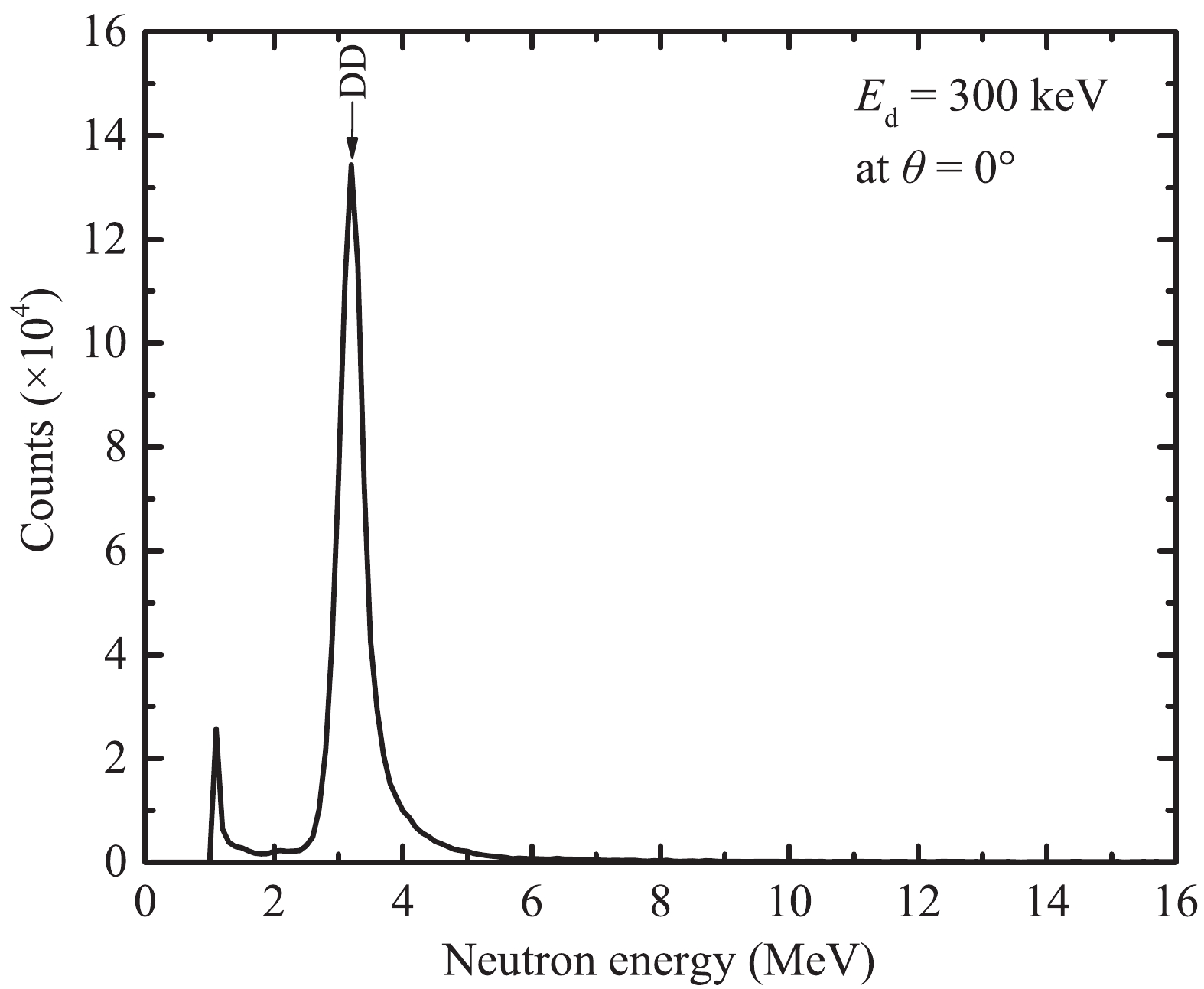
Figure 4. The measured neutron energy spectrum of the D(d,n)3He reaction, for a deuteron energy of 300 keV and neutron emission angle of 0°. The black arrow denotes the calculated neutron energy for the D(d,n)3He reaction.
Because the D(d,n)3He reaction is accompanied by the D(d,p)T reaction, the SSD can measure the associated protons, for monitoring the neutron yields of the D(d,n)3He reaction. With either the metallic beryllium target (self-injecting deuterons into the target) or the deuterium-adsorption target, associated protons from the D(d,p)T reaction can serve as a normalized standard. In excluding the neutrons from the D(d,n)3He reaction for the metallic beryllium target from the neutron energy spectrum of the 9Be(d,n)10B reaction, the experimentally measured D(d,n)3He neutron spectrum and 9Be(d,n)10B neutron spectrum should be normalized by proton counts measured by the SSD at
$ 135^\circ $ . The normalized 9Be(d,n)10B neutron energy spectrum, excluding the effect of the neutrons from the D(d,n)3He reaction, can be obtained by subtracting the normalized D(d,n)3He neutron energy spectrum from the normalzied 9Be(d,n)10B neutron energy spectrum and can be calculated using the following equation:$ n_{\rm net} = \frac{N_{\rm Be\_target}}{N(SSD)_{\rm Be\_target}}-\frac{N_{\rm D\_target}}{N(SSD)_{\rm D\_target}}, $

(4) where
$ n_{\rm net} $ is the normalized 9Be(d,n)10B neutron energy spectrum, excluding the effect of the D(d,n)3He reaction neutrons.$ N_{\rm Be\_target} $ and$ N(SSD)_{\rm Be\_target} $ represent the measured neutron energy spectrum of the 9Be(d,n)10B reaction and the counts of associated protons for the beryllium target.$ N_{\rm D\_target} $ and$ N(SSD)_{\rm D\_target} $ represent the measured neutron energy spectrum of the D(d,n)3He reaction and the counts of associated protons for the deuterium-absorption target. Typical results are shown in Fig. 5. Clearly, the D(d,n)3He reaction neutron peak at 3.23 MeV is excluded from the 9Be(d,n)10B neutron spectrum, validating the method for excluding the D(d,n)3He reaction neutrons. It should be emphasized that, as shown in Fig. 5, the rightmost peak corresponds to the neutrons from the D(d,n)3He reaction for the beam-limiting diaphragm, which do not affect the neutron energy spectrum distribution for the 9Be(d,n)10B reaction on the different excited states of 10B.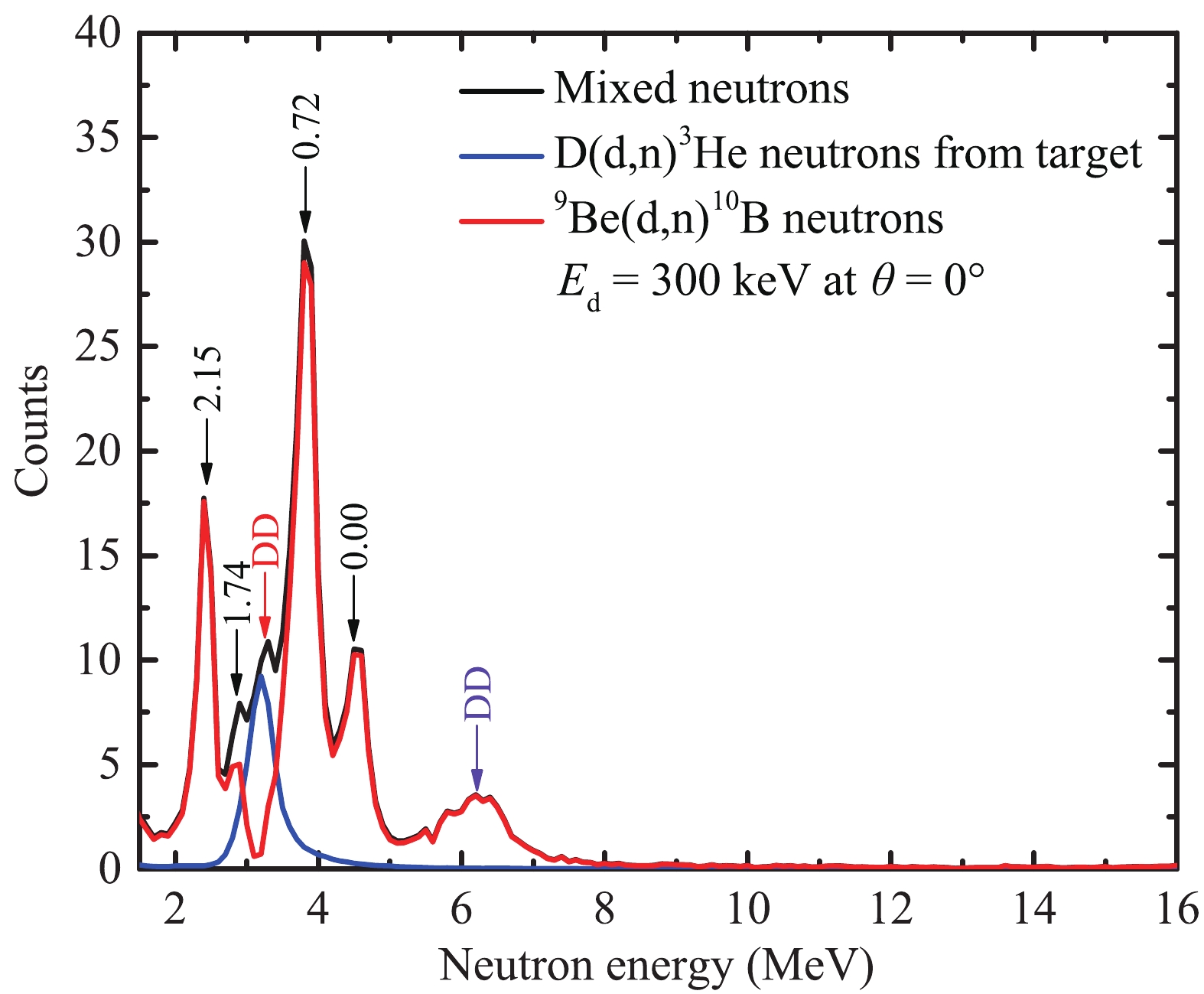
Figure 5. (color online) The normalized 9Be(d,n)10B neutron energy spectrum, excluding the neutrons of the D(d,n)3He reaction for the metallic beryllium target, for a deuteron energy of 300 keV and neutron emission angle of 0°. The arrows indicate the calculated neutron energies. The red and violet arrows denote the neutrons from the D(d,n)3He reaction for the metallic beryllium target and the beam-limiting diaphragm, respectively, and the black arrows are the neutrons from the 9Be(d,n)10B reaction, for 10B in different excited states.
Based on the above-mentioned data analysis method, the measured neutron energy spectra of the 9Be(d,n)10B reaction, excluding neutrons of the D(d,n)3He reaction for the metallic beryllium target, for deuteron energies of 250 and 300 keV and neutron emission angles of
$ 0^\circ $ and$ 45^\circ $ , are shown in Fig. 6. The neutron contributions from the 9Be(d,n)10B reaction are distributed relatively independently for different excited states of 10B (from right to left: the ground state ($ Q $ = 4.36 MeV), first excited state ($ Q $ = 3.64 MeV), second excited state ($ Q $ = 2.62 MeV), and third excited state ($ Q $ = 2.21 MeV) of 10B).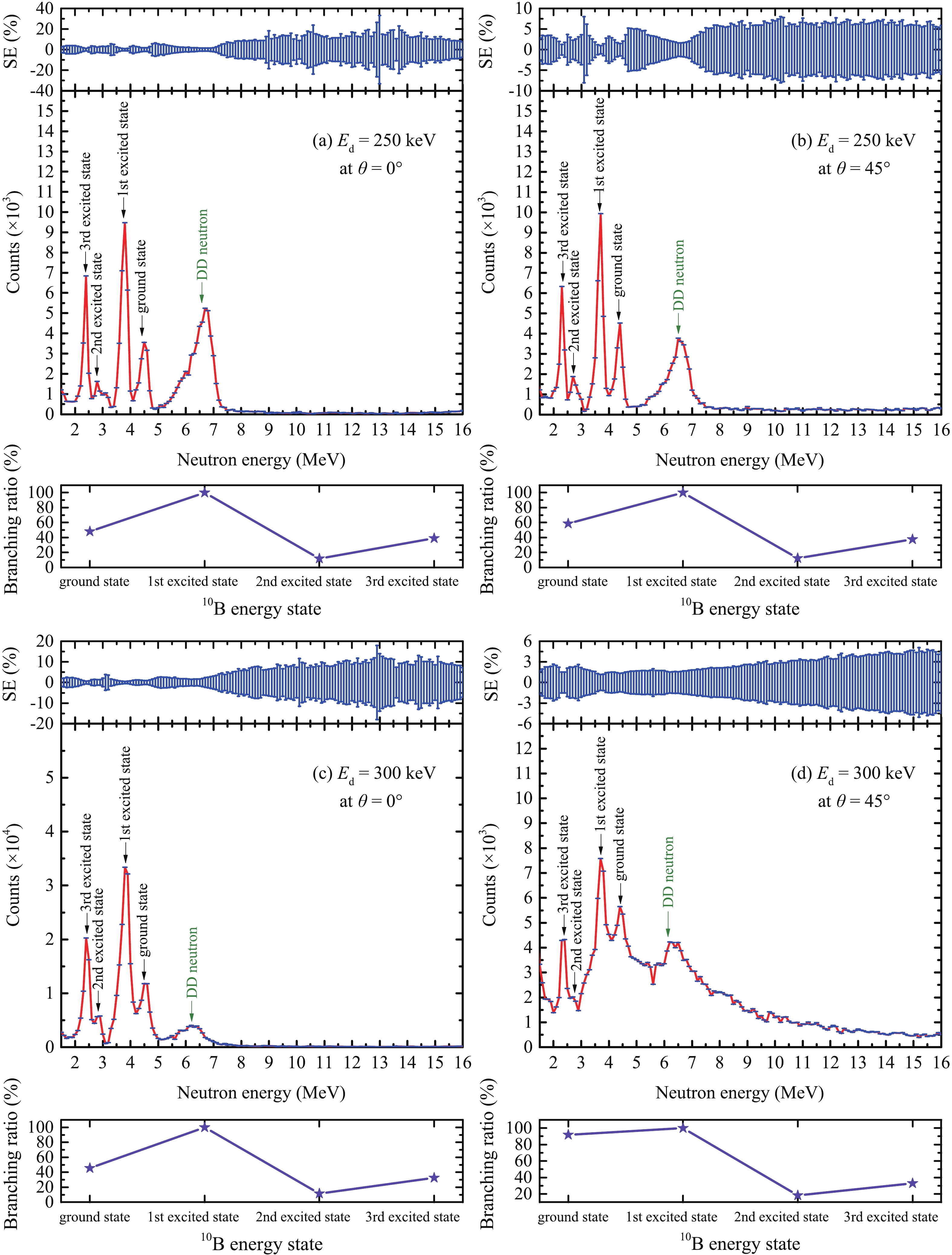
Figure 6. (color online) The measured neutron energy spectra of the 9Be(d,n)10B reaction, excluding the neutrons of the D(d,n)3He reaction for the metallic beryllium target, for deuteron energies of 250 and 300 keV and neutron emission angles of 0° and 45°. The olive arrow denotes the neutrons from the D(d,n)3He reaction, for the beam-limiting diaphragm. The black arrows indicate the neutrons from the 9Be(d,n)10B reaction, for 10B in different excited states.
Neutrons from the D(d,n)3He reaction for the beam-limiting diaphragm cannot be excluded, causing higher background in measured neutron energy spectra of the 9Be(d,n)10B reaction. According to the beam dynamics of the accelerator, with increasing energy of incident deuterons, the number of neutrons from the D(d,n)3He reaction for the beam-limiting diaphragm continues to increase owing to the space charge effects of deuterium ions, particularly at large neutron emission angles. Obviously, the background in Fig. 6(d) is higher than those in Fig. 6(a)-6(c).
From data analysis, the branching ratios of the 9Be(d,n)10B reaction were obtained for the different excited states of 10B, and the results are shown in Fig. 6. The branching ratios of the 9Be(d,n)10B reaction for the ground state, first excited state, second excited state, and third excited state are 48.21%, 100.00%, 11.99%, and 39.11%, respectively, for a deuteron energy of 250 keV and neutron emission angle of
$ 0^\circ $ . The branching ratios of the 9Be(d,n)10B reaction for the ground state, first excited state, second excited state, and third excited state are 58.61%, 100.00%, 12.43%, and 37.71%, respectively, for a deuteron energy of 250 keV and neutron emission angle of$ 45^\circ $ . The branching ratios of the 9Be(d,n)10B reaction for the ground state, first excited state, second excited state, and third excited state are 45.61%, 100.00%, 11.65%, and 32.61%, respectively, for a deuteron energy of 300 keV and neutron emission angle of$ 0^\circ $ . The branching ratios of the 9Be(d,n)10B reaction for the ground state, first excited state, second excited state, and third excited state are 91.85%, 100.00%, 18.31%, and 32.98%, respectively, for a deuteron energy of 300 keV and neutron emission angle of$ 45^\circ $ . With increasing incident deuteron energy, the branching ratio of the 9Be(d,n)10B reaction for the third excited state clearly decreases. With increasing neutron emission angle, the branching ratios for the ground state and the second excited state increase.The statistical error (SE) of the measured neutron energy spectra of the 9Be(d,n)10B reaction, excluding the neutrons from the D(d,n)3He reaction for the metallic beryllium target, was computed as 1/
$ \sqrt{N} $ , where$ N $ is the number of neutrons with a given energy in the spectrum; the calculation results are shown in Fig. 6. Clearly, the SEs of the neutron energy spectra are very small. The maximal SE values for the neutron peaks for 10B in the different excited states are 2.49% and 2.31% for a deuteron energy of 250 keV and neutron emission angles of$ 0^\circ $ and$ 45^\circ $ , and 1.32% and 2.23% for a deuteron energy of 300 keV and neutron emission angles of$ 0^\circ $ and$ 45^\circ $ , respectively.The energy resolution represents the ability of a TOF spectrometer to discriminate neutrons with similar energies and can be defined as [41]
$ \frac{\Delta E}{E} = \frac{2\Delta t}{t}+\frac{2\Delta L}{L}, $

(5) where
$ E $ is the neutron energy,$ \Delta E $ is the full width at half maximum,$ t $ is the neutron TOF, and$ L $ is the neutron flight length ($ L $ = 3.0 m).$ \Delta L $ is the uncertainty of the neutron flight distance, which is approximately 0.2 cm.$ \Delta t $ is given as$ \Delta t = [(\Delta t_{0})^2+(\Delta t_{h})^2+(\Delta t_{w})^2+(\Delta t_{s})^2+(\Delta t_{\Delta E})^2]^\frac{1}{2}, $

(6) where
$ \Delta t_{0} $ is the time width of the pulse beam, which is approximately 2.5 ns;$ \Delta t_{h} $ is the time uncertainty in the measurement owing to the crystal thickness of the scintillator detector, which can be calculated using$ \Delta t_{h} = 1.837/ \sqrt{E_{n}} $ ;$ \Delta t_{w} $ is the time uncertainty of the timing and time analyzer, which is approximately 0.5 ns;$ \Delta t_{s} $ is the uncertainty of the crossing time of the photomultiplier tube; and$ \Delta t_{\Delta E} $ is the time uncertainty caused by the neutron energy divergence owing to the scattering of primary neutrons in the target chamber. Both$ \Delta t_{s} $ and$ \Delta t_{\Delta E} $ can be neglected as they are small. Therefore, the uncertainty of the neutron TOF is$ \Delta t \!=\!\! \sqrt{(6.5\!\times\! E_{n}\!\!+\!\!3.375)/E_{n}} $ . The energy resolution as a function of the emitted neutron energy is shown in Fig. 7. Clearly, the neutron energy resolution of TOF is lower than 10% for neutron energies below 16 MeV. -
The neutron energy spectra of the 9Be(d,n)10B reaction with a thick beryllium target were measured using a fast neutron TOF spectrometer. The incident deuteron energies were 250 and 300 keV, and neutron emission angles were
$ 0^\circ $ and$ 45^\circ $ . In this work, the neutrons from the D(d,n)3He reaction for the metallic beryllium target were excluded from the neutron energy spectra of the 9Be(d,n)10B reaction. However, the neutrons from the D(d,n)3He reaction for the beam-limiting diaphragm were observed in the neutron energy spectra of the 9Be(d,n)10B reaction, which did not affect the neutron energy spectra distribution of the 9Be(d,n)10B reaction for different excited states of 10B.The neutron contributions from the 9Be(d,n)10B reaction were distributed relatively independently for different excited states of 10B, including the ground state, first excited state, second excited state, and third excited state of 10B. The branching ratios of the 9Be(d,n)10B reaction for different excited states of 10B were obtained for the neutron emission angles
$ \theta = 0^\circ $ and$ 45^\circ $ , and the incident deuteron energies were 250 and 300 keV, respectively. With increasing incident deuteron energy, the branching ratio of the 9Be(d,n)10B reaction for the third excited state clearly decreased. With increasing neutron emission angle, the branching ratios for the ground state and the second excited state increased. This work provides basic data for studying the physical mechanism of the 9Be(d,n)10B reaction, and it provides the neutron energy distributions for low-energy-accelerator-based D-Be neutron sources used in neutron physics and neutron applications.
Measurements of neutron energy spectra of 9Be(d,n)10B reaction with a thick beryllium target
- Received Date: 2020-08-07
- Available Online: 2021-02-15
Abstract: Novel measurements of the neutron energy spectra of the 9Be(d,n)10B reaction with a thick beryllium target are performed using a fast neutron time-of-flight (TOF) spectrometer for the neutron emission angles





 Abstract
Abstract HTML
HTML Reference
Reference Related
Related PDF
PDF



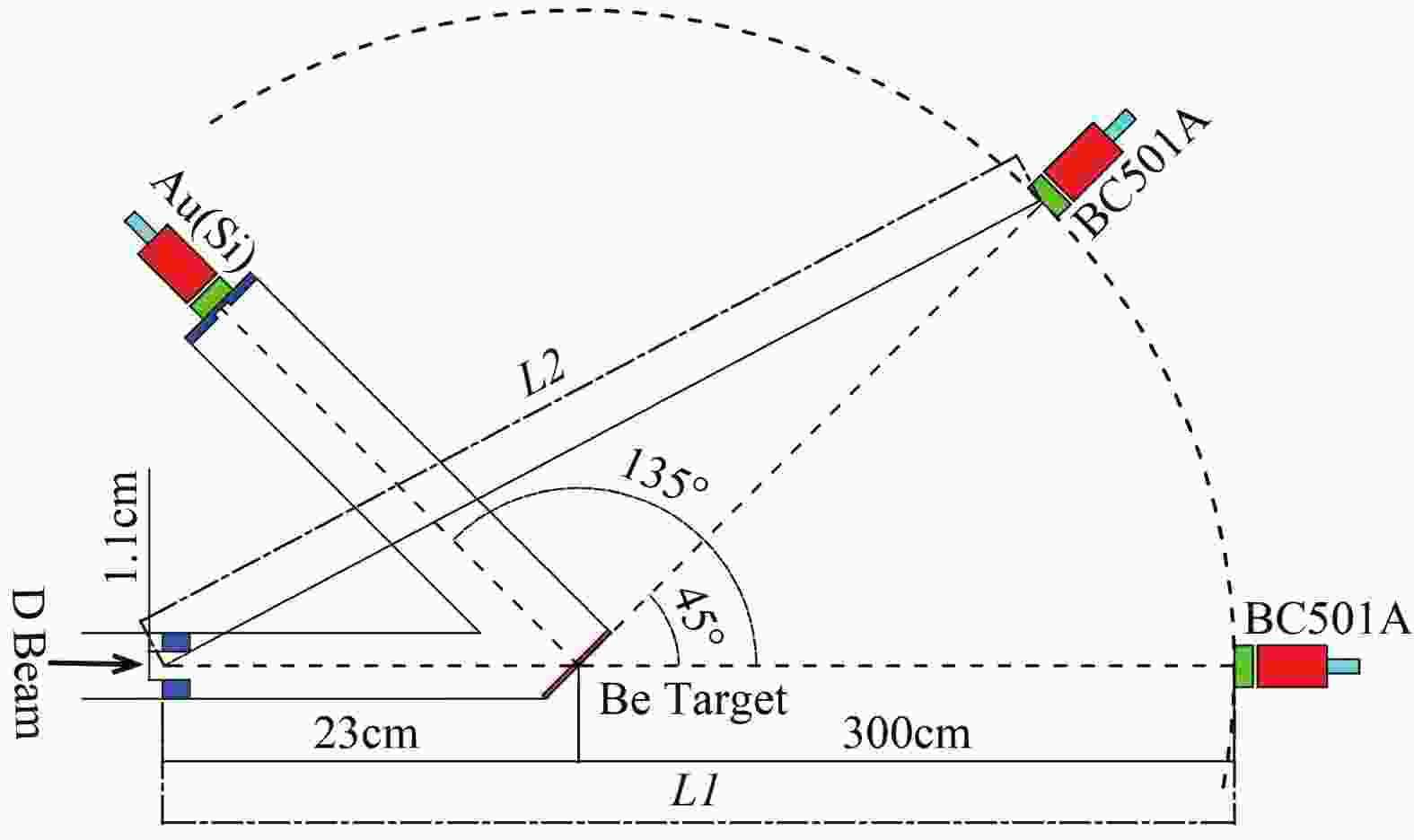














 DownLoad:
DownLoad: